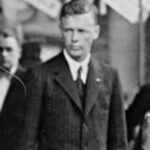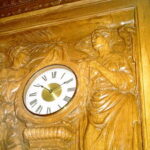Before Charles Lindbergh made history in 1927 by flying the first non-stop flight across the Atlantic Ocean from New York to Paris, he was a boy growing up in the small town of Little Falls, Minnesota on the banks of the Mississippi River. The house he grew up in was built in 1906, and today is preserved with the same furnishings that adorned it over 100 years ago. Charles Lindbergh was four years old when his family moved into their Little Falls Home.
Although the home remains in its original décor, the attached visitor center has several exhibits from Lindbergh’s life, starting with a mural of him as a boy gazing up at the sky. The last exhibit visitors see is a photograph of Lindbergh near his boyhood home in 1973, when he was 71 years old. Visitors also have the opportunity to sit in the cockpit of a model of The Spirit of St. Louis, the airplane Lindbergh flew for his historic flight across the ocean. Finally, there are several hundred actual photographs and artifacts displayed that had not been previously released to the public.
My two teenage daughters and I had the opportunity to tour the Lindberg home on their way home from summer camp last year. I am happy that we drove by it and decided to stop in. Although Little Falls is only about 90 minutes from our home, I may have never drove there on my own to see the Lindberg home. I would have missed out on a lot.
Lindbergh’s Rise to Fame
Charles Augustus Lindbergh was just 25 years old when he made his historic flight, pushing the shy young man from Minnesota into the spotlight whether he wanted to be or not. The son of a ten-year member of the House of Representatives, Lindbergh entered the University of Wisconsin in 1920 to study engineering. However, he was distracted in his studies by his interest in the new field of aviation. After two years as an undergraduate student, he left school to become a barnstormer, which is a daredevil pilot who performs for crowds at county fairs. Two years after that, Lindbergh began training for the US Army as a pilot, graduating from the US Army Flight School in 1925.
Prior to Lindbergh flying non-stop across the Atlantic in May of 1927, several pilots had attempted it and were injured or killed in the process. The pilots were all trying to win a $25,000 prize offered by a New York hotel owner named Raymond Ortieg to complete the transatlantic flight. When Lindbergh finally accomplished it, it took him 33 ½ hours after leaving New York to land in Paris.
After the First Flight
The public’s fascination with Charles Lindbergh took on a tragic twist when his 20-month-old son, Charles Jr., was kidnapped and murdered in 1932. Lindbergh, his wife and their surviving child were forced to move to Europe to escape the press who would not allow the family to grieve privately. Due to the circumstances of the toddler’s death, the “Lindbergh Law” was passed. This made anyone who took a kidnapping victim across state lines or who used the US Postal Service to make ransom demands guilty of a federal offense.
As the involvement of the United States in World War II became imminent, Lindbergh became an outspoken opponent. He was highly criticized by many in congress as well as Franklin D. Roosevelt, the President of the United States. After President Roosevelt publicly denounced him, Lindbergh resigned his post with the Army Air Corps.
Although Lindbergh changed his position after the Japanese bombed Pearl Harbor in December of 1941, the US military did not allow him to re-enlist. He then became an adviser and flew over 50 combat missions while officially classified as a civilian.
After the war ended, Charles Lindbergh withdrew from public life and lived with his family in Hawaii until his death in 1974.








